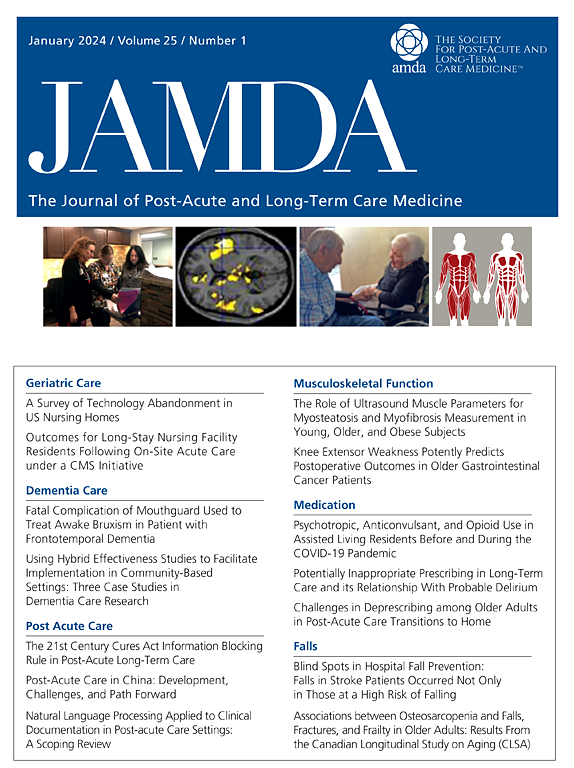Associations of 2 Established Methods of Measuring Gait Speed and Sit-To-Stand Performance with Frailty and Life-Space Mobility in Community-Dwelling Older Adults
IF 4.2
2区 医学
Q2 GERIATRICS & GERONTOLOGY
Journal of the American Medical Directors Association
Pub Date : 2024-10-02
DOI:10.1016/j.jamda.2024.105292
引用次数: 0
Abstract
Objectives
The 4-m gait speed (4mGS) and 10-m gait speed (10mGS) tests and the 30-second sit-to-stand (30sSTS) and 5-times sit-to-stand (5xSTS) tests are commonly used and advocated in consensus recommendations. We compared these tests on their predictive and clinical value concerning the risk of prefrailty/frailty and restricted life-space mobility (RLSM).
Design
Cross-sectional study.
Setting and Participants
A sample of 1235 community-dwelling adults (mean ± SD, 68 ± 7 years) participated in this prospective cohort study.
Methods
At baseline assessment, participants completed a survey and functional assessment, from which gait speed, sit-to-stand performance, self-reported mobility limitation, 40-item Frailty Index, and Life Space Assessment were measured. Participants with a 40-item Frailty Index >0.15 and a Life Space Assessment <60 points were classified as having prefrailty/frailty and RLSM, respectively. At 1-year follow-up assessment, prefrailty/frailty and RLSM were evaluated.
Results
Correlations between gait speed and sit-to-stand measures were high (ρ values >0.80). In multivariable ordinal models, these measures added incremental prognostic value beyond a base model comprising demographics and self-reported mobility limitation variables in predicting baseline and 1-year outcomes. Between 10mGS and 4mGS, models with 10mGS had higher concordance indices (differences, 0.005-0.009), and these differences translated to generally greater net benefit in decision curve analyses. Between 30sSTS and 5xSTS measures, no one measure consistently outperformed the other, with small net benefit differences between measures (<0.2%).
Conclusions and Implications
In community-dwelling older adults, gait speed and sit-to-stand measures meaningfully predicted prefrailty/frailty and RLSM. 10mGS provided more robust prognostic information than the 4mGS, whereas 5xSTS and 30sSTS measures showed near equivalence of performance. These findings could guide the choice of functional measures in clinical and research settings.
测量社区老年人步态速度和坐立表现的两种既定方法与虚弱程度和生活空间活动能力的关系。
目标:4米步速(4mGS)和10米步速(10mGS)测试以及30秒坐立(30sSTS)和5次坐立(5xSTS)测试是常用的测试方法,也是共识建议中的推荐方法。我们比较了这些测试对虚弱前兆/虚弱和生命空间移动受限(RLSM)风险的预测和临床价值:设计:横断面研究:1235名居住在社区的成年人(平均±标准差,68±7岁)参与了这项前瞻性队列研究:在基线评估中,参与者完成了一项调查和功能评估,其中包括步速、坐立表现、自我报告的行动受限情况、40 项虚弱指数和生活空间评估。40项虚弱指数大于0.15且生活空间评估结果为0.15的参与者将被淘汰:步速与坐立测量之间的相关性很高(ρ 值大于 0.80)。在多变量序数模型中,这些测量指标在预测基线和 1 年预后时,比人口统计学和自我报告的活动受限变量组成的基础模型更具增量预后价值。在 10mGS 和 4mGS 之间,采用 10mGS 的模型具有更高的一致性指数(差异,0.005-0.009),这些差异在决策曲线分析中转化为更大的净获益。在 30sSTS 和 5xSTS 两种测量方法之间,没有一种测量方法始终优于另一种测量方法,不同测量方法之间的净效益差异较小(结论和启示:在社区居住的老年人中,步态速度和坐立测量可有意义地预测虚弱前/虚弱和 RLSM。与 4mGS 相比,10mGS 能提供更可靠的预后信息,而 5xSTS 和 30sSTS 两种测量方法的性能几乎相当。这些发现可为临床和研究环境中功能测量的选择提供指导。
本文章由计算机程序翻译,如有差异,请以英文原文为准。
求助全文
约1分钟内获得全文
求助全文
来源期刊
CiteScore
11.10
自引率
6.60%
发文量
472
审稿时长
44 days
期刊介绍:
JAMDA, the official journal of AMDA - The Society for Post-Acute and Long-Term Care Medicine, is a leading peer-reviewed publication that offers practical information and research geared towards healthcare professionals in the post-acute and long-term care fields. It is also a valuable resource for policy-makers, organizational leaders, educators, and advocates.
The journal provides essential information for various healthcare professionals such as medical directors, attending physicians, nurses, consultant pharmacists, geriatric psychiatrists, nurse practitioners, physician assistants, physical and occupational therapists, social workers, and others involved in providing, overseeing, and promoting quality

 求助内容:
求助内容: 应助结果提醒方式:
应助结果提醒方式:


